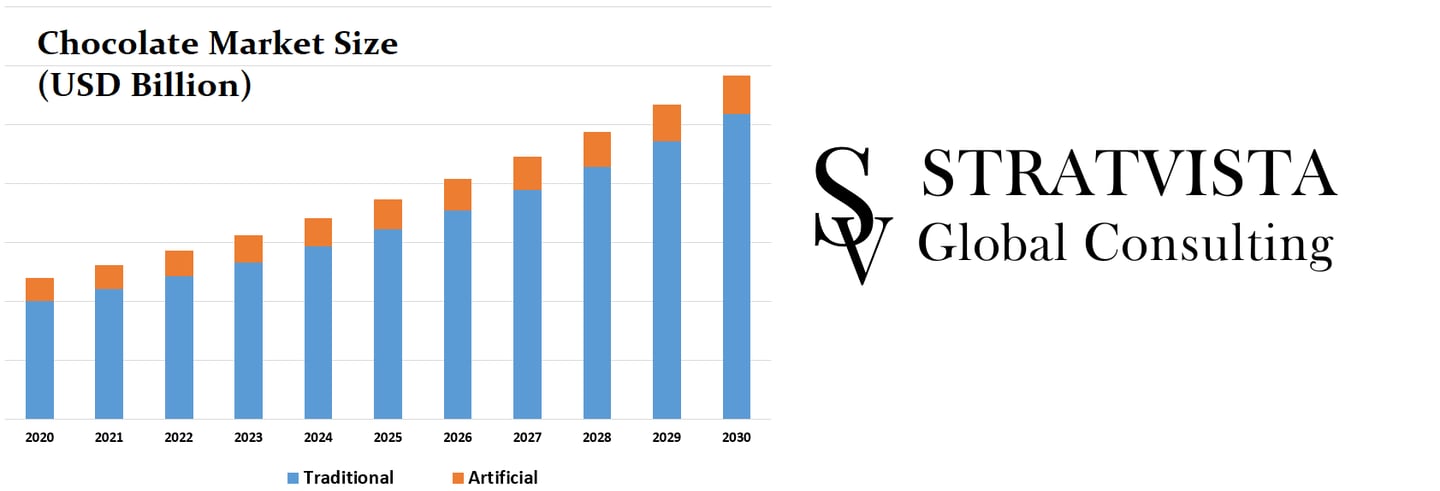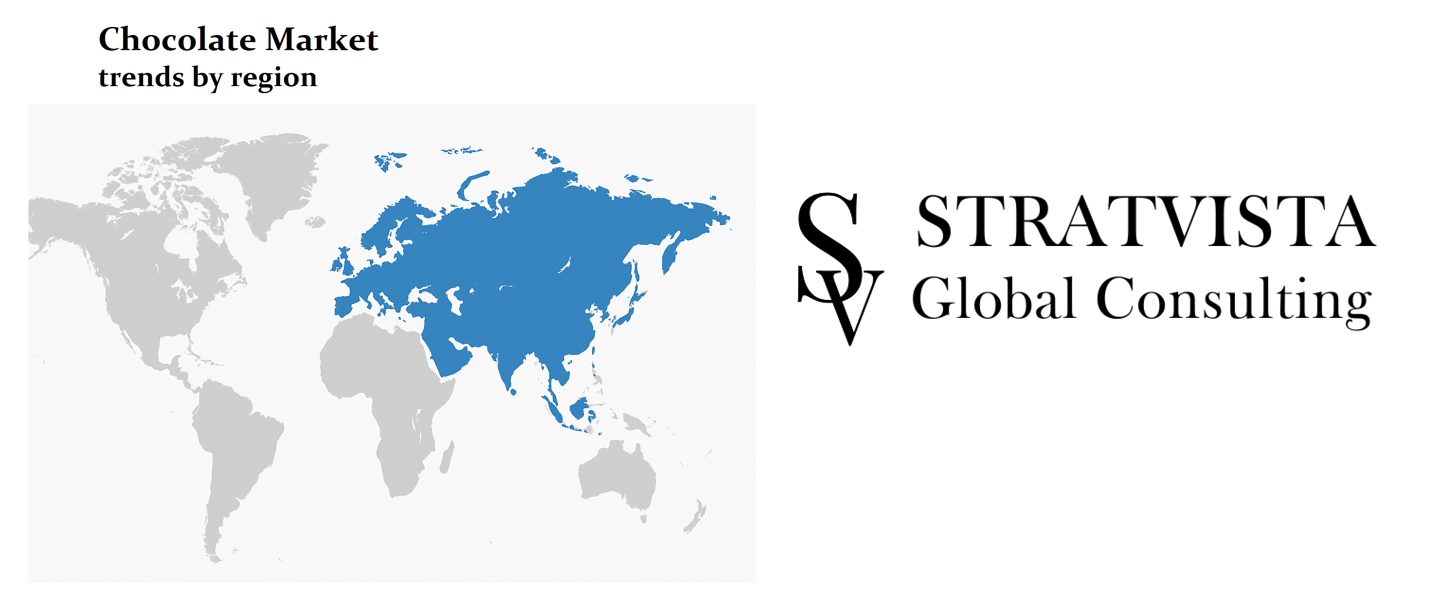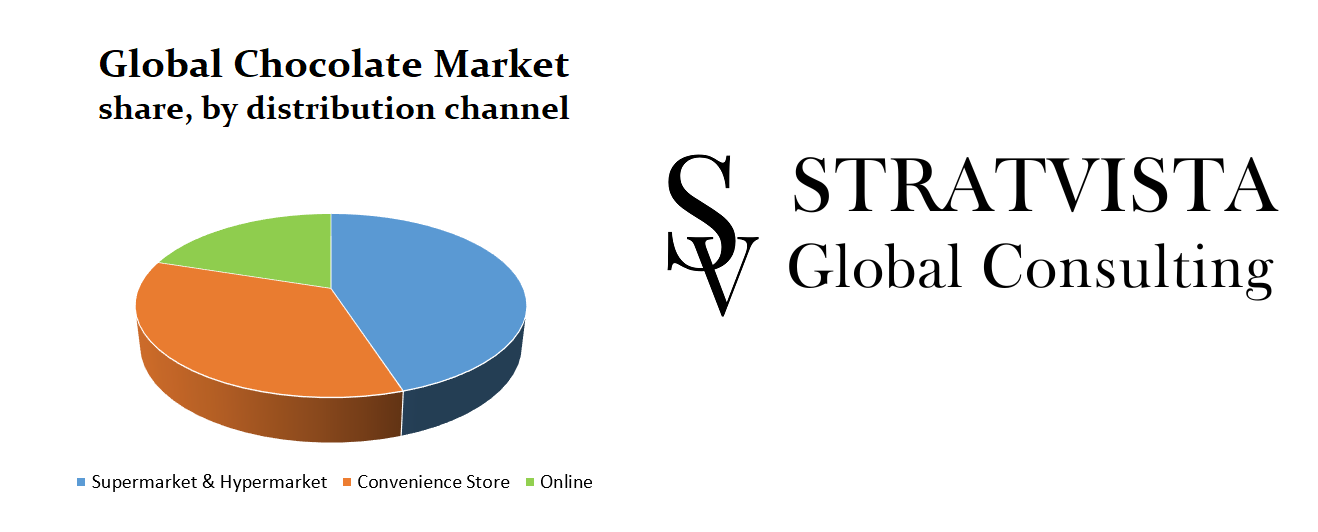Chocolate Market Size, Share & Trends Analysis Report By Product (Traditional, Artificial), By Distribution Channel (Supermarket & Hypermarket, Convenience Store, Online), By Region, And Segment Forecasts
Fully Customizable Report
Choose Market Region
Finalize Table of Contents
Get the Report Delivered in at least 15 days
12 weeks after sales support
Deliverable Format: PDF
Chocolate Market Size & Trends
The global chocolate market was valued at USD xxx.xx billion in 2023 and is expected to grow at a CAGR of x.x% from 2024 to 2030, driven by increasing consumer awareness of the health benefits of high-quality chocolate and the rising demand for vegan, organic, gluten-free, and sugar-free varieties. While the COVID-19 pandemic initially disrupted the global supply chain, chocolate consumption surged as consumers stocked up on packaged foods, with sales rising x.x% in 2020. The market is further fueled by innovations in sustainable sourcing, ethical production, and functional ingredients, positioning premium and health-conscious chocolates as key growth drivers in the coming years.


The global chocolate market is experiencing steady growth, driven by increasing consumer preference for chocolate as a stress-relief and mood-enhancing treat, particularly during the COVID-19 pandemic. Many consumers turned to chocolate to alleviate stress and improve mood, ensuring stable demand even during economic uncertainties. The shift toward bean-to-bar and single-origin chocolates over mass-produced variants is encouraging manufacturers to invest in premium and specialty products, further boosting market expansion.
The single-origin cocoa trend continues to fuel new product innovation, as consumers seek higher-quality, ethically sourced chocolates with unique flavor profiles. Growing awareness of the health benefits of moderate chocolate consumption is another major driver. Health experts highlight that chocolate boosts serotonin levels, acting as a natural antidepressant, while also triggering the release of endorphins, which enhance mood and reduce stress. With approximately x.x% of the global population affected by depression, the demand for chocolate as a functional food is expected to rise in the coming years.
Additionally, chocolate consumption is linked to the regulation of cortisol (the stress hormone), which promotes mental well-being and may reduce dependence on medication. The increasing focus on preventive healthcare is further propelling market demand, as consumers look for natural ways to improve mental health.
Another key factor influencing the market is the rising awareness of dark chocolate’s health benefits. According to the Cleveland Clinic, dark chocolate supports better blood circulation, lower blood pressure, improved brain function, and reduced risk of heart disease, thanks to its rich content of zinc, magnesium, phosphorus, copper, and iron. Furthermore, the premiumization of chocolate-based products and the use of aesthetic, visually appealing packaging are enhancing consumer interest, driving higher sales and long-term market growth.
Market Concentration & Characteristics
The global chocolate market is experiencing significant growth, driven by the rising demand for premium and high-quality chocolate products, the increasing popularity of dark chocolate for its health benefits, and the growing consumer preference for organic and sustainable chocolates. The market is further fueled by continuous innovation in flavors and product varieties, along with the expansion of the chocolate industry in emerging markets, creating new opportunities for manufacturers.
Additionally, the widespread use of chocolate in bakery products, confectionery, and beverages is contributing to market expansion. The rising awareness of dark chocolate’s health benefits, including its role in improving heart health, brain function, and reducing stress, is further influencing consumer choices. Moreover, the development of new distribution channels, including e-commerce and specialty stores, is enhancing product accessibility, driving sales, and supporting overall chocolate market growth.
Product Insights
The traditional chocolate market dominated global revenues in 2023, holding over xx% market share, driven by the high popularity, wide availability, and deep market penetration of cocoa-based chocolates compared to artificial chocolate alternatives like carob. Among traditional chocolates, the milk chocolate segment led the market, thanks to its rich flavonoid content, which acts as an antioxidant, improves blood flow, and removes free radicals from the bloodstream. The rising consumer purchasing power and increasing awareness of milk chocolate’s health benefits have further fueled its global demand.
Meanwhile, the artificial chocolate market is projected to grow at an impressive CAGR of x.x% from 2024 to 2030, as consumers seek caffeine-free alternatives like carob confectionery, which is ideal for caffeine-intolerant individuals. According to Caffeine Informer, xx% of the global population has hyposensitivity to caffeine. Additionally, carob contains nearly x times more calcium than cocoa, making it a preferred choice for individuals with calcium deficiencies, particularly among women.
In the chocolate spreads market, Nutella from Ferrero India remains the dominant player, despite being an imported product. Globally, Ferrero continues to strengthen its position in the chocolate confectionery market, as demonstrated by the 2020 launch of Nutella biscuits, which achieved sales of over xx million units. The brand's success highlights the growing consumer preference for premium and innovative chocolate-based products, further driving market expansion.
The online distribution channel in the global chocolate market is projected to grow at the fastest CAGR of x.x% from 2024 to 2030, driven by rising internet penetration, increasing online shoppers, and the convenience of doorstep delivery. Consumers are increasingly opting for e-commerce platforms due to the availability of multiple brands, easy price comparisons, and exclusive discounts. Additionally, online retailers offering cash on delivery, cashback rewards, and promotional discounts are further accelerating the shift toward digital sales, making online channels a key growth driver in the chocolate industry.
Despite the rapid growth of online sales, supermarkets and hypermarkets remained the leading distribution channels in 2023, accounting for a revenue share of over xx.xx%. The extensive product range, strong brand presence, and in-store promotions in physical retail outlets continue to attract a large consumer base. Many shoppers prefer brick-and-mortar stores for the immediate availability of products and the ability to inspect them in person. Additionally, leading chocolate manufacturers are expanding their presence in malls and retail chains to capitalize on the growing consumer demand, further boosting sales in supermarkets and hypermarkets in the coming years.
Distribution Channel Insights
The online distribution channel is projected to experience the highest CAGR of x.x% from 2024 to 2030, driven by increasing internet penetration and the rising number of online shoppers worldwide. Consumers are shifting towards e-commerce platforms due to the convenience of home delivery, access to multiple brands, and exclusive discounts. Additionally, features such as cash on delivery (COD), cashback offers, and promotional discounts are further fueling the rapid expansion of online retail channels in the chocolate market.
Despite the surge in online sales, supermarkets and hypermarkets remained the leading distribution channel in 2023, capturing a xx.xx% revenue share. Consumers continue to prefer physical retail stores for an enhanced shopping experience, allowing them to inspect products firsthand and make instant purchases. The increasing consumer demand for chocolates has also encouraged manufacturers to expand retail presence in malls and shopping centers, boosting in-store chocolate sales.
With the growing adoption of online shopping and the sustained dominance of supermarkets, the chocolate distribution market is set for significant transformation in the coming years.
Chocolate Production Cost Report 2025
Regional Insights
The Europe chocolate market dominated global revenues in 2023, accounting for xx.xx% of the total market share. The rising demand for dark chocolate, driven by growing consumer awareness of its health benefits, is a major factor fueling regional market growth. According to ITC Trade Map (2020), Europe imported nearly x thousand tons of chocolate products, making it the largest chocolate-producing region. Additionally, Europe boasts the highest per capita chocolate consumption at x kilograms, as per CBI, Ministry of Foreign Affairs. These trends indicate continued expansion in the European chocolate industry in the coming years.
The Middle East and Africa chocolate market is set to grow at the fastest CAGR of x.x% from 2024 to 2030. This robust growth is attributed to increased product availability in retail stores, along with supportive government policies, such as tax benefits for chocolate producers and grinders. Additionally, the region is witnessing a surge in artisanal chocolate demand, rising disposable incomes among middle-class consumers, and innovative channel development strategies by manufacturers to enhance market reach.
Meanwhile, the North America chocolate market is projected to expand at a CAGR of x.x% from 2024 to 2030, primarily driven by the growing demand for premium and specialty chocolates. The increasing preference for dark chocolate, due to its numerous health benefits, and the rising popularity of organic and ethically sourced chocolates are key factors supporting market growth in the region.
As global chocolate consumption trends continue to evolve, manufacturers and retailers are focusing on product innovation, sustainability, and premium offerings to cater to shifting consumer preferences.
Canada Chocolate Market: Premium & Artisanal Chocolates Driving Growth
The Canada chocolate market is experiencing significant growth, driven by the increasing demand for premium and artisanal chocolates. Consumers are becoming more aware of the health benefits of dark chocolate, fueling demand for organic and fair-trade chocolate products. Additionally, innovative product launches, unique flavor combinations, and the expansion of online retail channels are key factors boosting the market. As e-commerce and specialty chocolate stores gain traction, Canada’s chocolate industry is expected to witness steady growth in the coming years.
Mexico Chocolate Market: Rich Cacao Tradition & Growing Global Demand
The Mexico chocolate market is thriving, thanks to the country’s rich history of cacao cultivation and the growing demand for high-quality, organic chocolate. Mexican chocolate is gaining international popularity, with an increasing focus on bean-to-bar chocolate makers and innovative flavor infusions. Additionally, the promotion of Mexican chocolate as a gourmet product is elevating its status in both domestic and global markets. As a result, export opportunities, along with a rising preference for premium and artisanal chocolates, are set to drive significant market expansion.
India Chocolate Market: Western Influence & Retail Expansion Fueling Growth
The India chocolate market is rapidly expanding, driven by changing consumer preferences and the increasing influence of Western culture. The demand for premium and artisanal chocolates is on the rise, supported by the growing middle-class population and their willingness to spend on luxury confectionery products. Moreover, the expansion of retail channels, including supermarkets, hypermarkets, and online platforms, has made chocolates more accessible across urban and rural areas. These factors have contributed to a surge in chocolate consumption, making India one of the fastest-growing chocolate markets globally.
The chocolate markets in Canada, Mexico, and India are witnessing remarkable growth due to premiumization, health-conscious consumption, and retail innovations. As consumer preferences continue to evolve, organic, fair-trade, and artisanal chocolates will play a crucial role in shaping the future of the global chocolate industry.
Key Chocolate Company Insights
In the global chocolate market, leading companies are driving growth through innovative product development tailored to evolving consumer tastes. To stay ahead, these industry giants focus on launching premium, artisanal, and health-oriented chocolate products that meet the latest market demands. They further strengthen their competitive edge by forging strategic partnerships, pursuing mergers, establishing joint ventures, and expanding their operations geographically.
Key Chocolate Companies:
Here are the top companies shaping the chocolate market, holding the largest market share and influencing global industry trends.
Barry Callebaut
Chocoladefabriken Lindt & Sprüngli AG
Mondelēz International, Inc.
Nestlé
The Hershey Company
Ferrero Group
Mars, Incorporated
The Australian Carob Co.
Meiji Holdings Co., Ltd.
Arcor
Recent Developments
In October 2023, Mondelēz International repositioned the iconic Toblerone brand as a premium luxury chocolate with its innovative "Never Square" campaign. Inspired by high-end luxury brands, the campaign redefines Toblerone as a unique, high-quality treat. To reinforce this new brand identity, Toblerone introduced creative formats—including Toblerone Truffles with a velvety smooth center and a distinctive diamond shape—and expanded its Tiny Toblerone packs to U.S. retailers, making the product more accessible for mindful snacking.
In October 2022, Barry Callebaut, a global leader in high-quality chocolate and cocoa products, unveiled its second generation of chocolate. This innovative product focuses on higher cocoa content and reduced sugar levels by applying the Cocoa Cultivation & Craft principle. The result is a chocolate formulation containing 60-80% more cocoa and 50% less sugar, offering a healthier, more indulgent option that highlights the unique flavors of each cocoa bean.
Earlier, in January 2021, Mars Inc. tapped into the growing demand for plant-based products by launching two new vegan chocolate bars during Veganuary. The introduction of Topic Vegan and Bounty Vegan complemented Mars' existing vegan portfolio, which includes a vegan version of Galaxy chocolate, catering to consumers committed to a vegan lifestyle and expanding the market for premium, vegan chocolate options.
How Our Chocolate Market Analysis Report Helps Your Business Grow?
Our Chocolate Market Intelligence Report provides in-depth insights to help CEOs, COOs, and Procurement Managers make data-driven decisions, optimize sourcing strategies, and stay ahead of industry trends. Here’s how this report benefits your business:
Key Benefits of Our Chocolate Market Report:
✅ Comprehensive Market Insights – Gain a deep understanding of market size, growth trends, competitive landscape, and emerging opportunities in the global chocolate industry.
✅ Strategic Sourcing & Procurement Intelligence – Optimize supplier selection, raw material sourcing, pricing strategies, and cost-saving opportunities for better procurement decisions.
✅Consumer & Demand Trends Analysis – Understand changing consumer preferences, including the rising demand for premium, organic, and functional chocolates.
✅ Competitive Benchmarking – Compare leading chocolate manufacturers, analyze market share, pricing strategies, and innovation trends to stay competitive.
✅ Regional Growth Opportunities – Identify high-growth regions, emerging markets, and investment hotspots for expanding your business operations.
✅Regulatory & Compliance Insights – Stay updated on food safety regulations, labeling requirements, and trade policies impacting the chocolate industry.
✅ Technology & Innovation Trends – Explore new production techniques, sustainable packaging solutions, and advancements in chocolate manufacturing.
What Else We Provide to Help Your Business Grow Globally:
🔹 Customized Market Intelligence – Tailored insights specific to your business needs, including market entry strategies, partnership opportunities, and risk analysis.
🔹 Supply Chain Optimization – Enhance efficiency with logistics insights, supplier risk assessment, and cost reduction strategies.
🔹Consumer Behavior Insights – Leverage data on regional consumer preferences, spending patterns, and digital purchasing trends for targeted marketing.
🔹Investment & Expansion Strategies – Identify M&A opportunities, new product development areas, and competitive positioning strategies for growth.
🔹 Sustainability & ESG Trends – Adapt to the latest eco-friendly production methods, ethical sourcing, and carbon footprint reduction strategies.
Our report equips global chocolate industry leaders with actionable intelligence to drive business growth, enhance profitability, and make informed decisions.
Ready to Gain a Competitive Edge?
Contact us today to access exclusive market insights and drive your company’s success in the chocolate industry!






Qualitative Analysis
Industry overview: This section provides a broad understanding of the industry, including its history, current status, and expected future developments. It outlines the industry structure, key segments, major players, and the overall economic impact.
Industry trends: Industry trends highlight ongoing changes and evolving patterns within the sector. These could include:
Technological advancements
Regulatory changes (new laws or compliance requirements)
Consumer preferences (shifts in demand and buying behavior)
Sustainability initiatives (green energy, eco-friendly products)
Market drivers and restraints:
Market Drivers: Factors that boost industry growth, such as increasing demand, government support, technological advancements, or cost reductions.
Market Restraints: Challenges that hinder growth, including high costs, regulatory hurdles, market saturation, or supply chain disruptions.
Market size: Market size refers to the total value or volume of the industry, typically measured in revenue (USD) or units sold. It includes:
Current market valuation
Historical data and growth patterns
Future projections (CAGR, expected growth over a specific period)
Growth prospects: This section discusses potential areas of expansion and future opportunities, including:
Emerging markets with high demand
New product innovations
Strategic partnerships and mergers
Untapped customer segments
Porter’s analysis: A strategic framework that evaluates competitive forces in an industry:
Threat of New Entrants – How easy it is for new companies to enter the market.
Bargaining Power of Suppliers – Influence of suppliers on pricing and supply.
Bargaining Power of Buyers – Influence of customers on pricing and demand.
Threat of Substitutes – Availability of alternative products or services.
Industry Rivalry – Competitive intensity among existing players.
PESTEL analysis: A macro-environmental analysis that examines external factors affecting the industry
Political (government policies, trade regulations)
Economic (inflation, exchange rates, GDP growth)
Social (consumer behavior, demographics, lifestyle changes)
Technological (R&D, digital transformation)
Environmental (sustainability, climate policies)
Legal (labor laws, compliance, industry regulations)
Key market opportunities prioritized: Identifies the most lucrative opportunities within the industry, ranked based on factors such as market demand, profitability, competition, and feasibility. It helps businesses focus on high-potential areas for investment.
Competitive landscape: A detailed analysis of the major industry players, including
Market share analysis
Key differentiators (pricing, technology, customer service, etc.)
Strategies for market positioning
Competitive strengths and weaknesses
Company overview: A summary of key companies in the industry, including
Corporate structure
Business operations and product offerings
Geographical presence
Financial performance: A company’s financial health assessment, covering
Revenue, profit margins, and cash flow
Debt levels and investment trends
Year-over-year (YoY) growth comparison
Product benchmarking: A comparative analysis of key products offered by major competitors, focusing on
Features and specifications
Pricing strategies
Performance metrics
Market positioning
Latest strategic developments: Covers recent business moves made by key companies, including
Mergers and acquisitions (M&A)
Product launches and innovations
Partnerships and collaborations
Investment and expansion plans
Regulatory approvals
Quantitative Analysis
Market size, estimates and forecast
Market estimates and forecast for product segments
Regional market size and forecast for product segments
Market estimates and forecast for application segments
Regional market size and forecast for application segments
Company financial performance
Starting from USD 2299
Management Consulting
© 2025 StratVista Global Consulting. All rights reserved.
Navigating Success with Strategy & Vision
Subscribe to Our Newsletter
Get updated with the latest commodity prices and trends


StratVista
Global
Consulting
